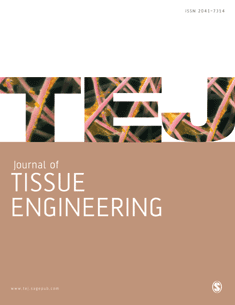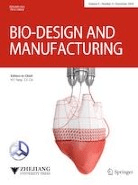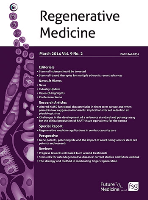
Bioelectricity
metrics 2024
Advancing Biomedical Frontiers with Electric Innovations
Introduction
Bioelectricity, published by MARY ANN LIEBERT, INC, is an esteemed journal dedicated to the interdisciplinary field that bridges biomedical engineering and electrical engineering, promoting research and innovation in the use of electrical signals for biological applications. Since its inception in 2019, the journal has established a solid reputation within the academic community, evidenced by its categorization in the Q3 quartile for Biomedical Engineering, Electrical and Electronic Engineering, and Medicine, alongside a notable Q2 ranking in Transplantation for 2023. With an ISSN of 2576-3105, Bioelectricity serves as a pivotal platform for disseminating cutting-edge research and fostering advancements in technology and medicine, drawing contributions from scholars globally. Although the journal operates under a traditional access model, it remains a critical resource for researchers, professionals, and students keen on exploring the potential of bioelectric phenomena in medical treatments and devices. As the field continues to evolve, Bioelectricity plays a vital role in shaping discussions and insights that propel innovations in health and engineering.
Metrics 2024
 0.40
0.40 1.60
1.60 2.40
2.40 15
15Metrics History
Rank 2024
Scopus
IF (Web Of Science)
JCI (Web Of Science)
Quartile History
Similar Journals

Biomaterials Research
Leading the charge in materials innovation.Biomaterials Research, published by the American Association for the Advancement of Science, is a prominent open access journal established in 2014, dedicated to advancing the field of biomaterials. Based in the United Kingdom, this journal has swiftly become an essential platform for researchers and practitioners, offering groundbreaking insights in biomaterials, biomedical engineering, ceramics and composites, and miscellaneous medical fields. With its impressive Q1 ranking across multiple relevant categories in 2023 and its strong Scopus rankings, including a remarkable 90th percentile in the medicine category, Biomaterials Research showcases high-quality, peer-reviewed research designed to address both practical and theoretical challenges in biomaterials science. As an open access journal, it promotes wider dissemination and accessibility of research findings, crucial for fostering innovation and collaboration within the scientific community. Researchers, professionals, and students alike are encouraged to contribute, read, and engage with the latest developments in this dynamic field.

Photobiomodulation Photomedicine and Laser Surgery
Transforming Healthcare Through Photobiomodulation InsightsPhotobiomodulation Photomedicine and Laser Surgery is a premier peer-reviewed journal published by MARY ANN LIEBERT, INC, dedicated to advancing the understanding of light-based therapies in biomedical applications. With an impressive impact factor, this journal occupies a significant position in the field of Biomedical Engineering and Radiology, Nuclear Medicine and Imaging, evidenced by its placement in the Q3 category for both fields as of 2023. The journal's scope encompasses a wide array of research topics, including but not limited to, the therapeutic effects of photobiomodulation and innovative laser surgical techniques. Researchers and practitioners alike can benefit from its open-access format, facilitating the dissemination of cutting-edge findings to a global audience. By bridging the gap between scientific inquiry and clinical application, Photobiomodulation Photomedicine and Laser Surgery plays a crucial role in fostering the integration of advanced technologies in healthcare, enhancing patient outcomes and pushing the boundaries of medical science.

EUROPEAN BIOPHYSICS JOURNAL WITH BIOPHYSICS LETTERS
Elevating Knowledge in Biophysics and BeyondEuropean Biophysics Journal with Biophysics Letters is a leading academic journal published by Springer that focuses on innovative research in the field of biophysics. Founded in 1984, it has consistently provided a platform for the dissemination of high-quality scientific findings, bridging the gap between biophysics and its applications in medicine and related fields. With an ISSN of 0175-7571 and an E-ISSN of 1432-1017, this journal has established itself as a Q2-rated publication in both Biophysics and Miscellaneous Medicine, highlighting its influential role in advancing knowledge and fostering collaboration among researchers. The journal features original research articles, reviews, and technical notes that contribute significantly to our understanding of biological systems at a molecular level. Although it does not offer an open-access model, the journal remains committed to promoting scholarly communication and enhancing the visibility of biophysical research globally. By maintaining a Scopus Rank of #74/152 within the category of Biochemistry, Genetics and Molecular Biology, it positions itself as an essential resource for professionals, researchers, and students aiming to stay at the forefront of biophysical science.

Journal of Tissue Engineering
Transforming Healthcare Through Cutting-Edge ResearchThe Journal of Tissue Engineering, published by SAGE Publications Inc., stands at the forefront of innovation in the interdisciplinary fields of biomaterials and biomedical engineering. Established as an open access journal since 2010, it has quickly ascended to a leading position, as evidenced by its impressive rankings in 2023: Q1 in Biomaterials, Q1 in Biomedical Engineering, and Q1 in Medicine (miscellaneous). With a current impact factor that underscores its academic influence, this journal provides a vital platform for researchers, professionals, and students to share groundbreaking discoveries and advancements in tissue engineering and regenerative medicine. Located in the United Kingdom, the journal fosters a global dialogue with its robust publications and rigorous peer-review process, contributing significantly to the enhancement and understanding of complex biological systems. Join the esteemed community of thought leaders and innovators shaping the future of healthcare through the Journal of Tissue Engineering.

Bio-Design and Manufacturing
Innovating Tomorrow's Bio-Manufacturing SolutionsBio-Design and Manufacturing, published by SPRINGER HEIDELBERG, is a pioneering journal that stands at the forefront of innovation in the fields of Biomedical Engineering, Biotechnology, Industrial and Manufacturing Engineering, and Materials Science. With its ISSN 2096-5524 and E-ISSN 2522-8552, this journal has established itself as a leading platform for disseminating cutting-edge research and advancements that merge biological principles with manufacturing processes, emphasizing sustainable and efficient practices. It has garnered recognition in the 2023 category quartiles, boasting a Q1 rank in all its relevant fields, which underscores its significance and impact—evident from its prime Scopus rankings that place it within the top percentiles of numerous engineering and materials science disciplines. Researchers, professionals, and students alike benefit from the wealth of knowledge presented in this journal, making it an essential resource for those seeking to enhance their understanding of bio-design applications and innovation in manufacturing processes.

Membranes
Transforming challenges into solutions through membrane expertise.Membranes, published by MDPI since 2011, is an esteemed open access journal dedicated to advancing the field of membrane science and technology. With an E-ISSN of 2077-0375, this journal serves as a vital platform for researchers and professionals from various disciplines such as chemical engineering, filtration, and separation technologies. Holding a commendable Q2 ranking in Chemical Engineering (miscellaneous) and notable placement in filtration and process chemistry categories, it provides a robust framework for researchers to disseminate groundbreaking findings. The journal's commitment to open access ensures a wide-reaching impact, allowing for unrestricted sharing of high-quality research that addresses the critical challenges and innovations in membrane technology. Situated in Switzerland, Membranes is not only a cornerstone for academic inquiry but also a leading resource for students and industry experts seeking cutting-edge developments in their fields.

Stem Cells International
Innovating Tomorrow's Therapies Through Stem Cell ScienceStem Cells International is a premier open access journal published by HINDAWI LTD, focusing on the rapidly evolving field of stem cell research. With an ISSN of 1687-966X and E-ISSN 1687-9678, this journal has been a vital resource since its inception in 2010, showcasing innovative studies and breakthroughs up to 2024. Positioned in Q3 in Cell Biology and Q2 in Molecular Biology for 2023, as well as well-ranked in the Scopus database, the journal serves as an essential platform for researchers, professionals, and students dedicated to exploring the implications of stem cell technology in regenerative medicine and biological research. The open access model ensures wide accessibility, fostering collaboration and knowledge-sharing across the scientific community, making it a cornerstone in advancing the understanding and application of stem cell science.

JOURNAL OF MEMBRANE BIOLOGY
Bridging Biology and Technology through Membrane StudiesWelcome to the Journal of Membrane Biology, a premier publication dedicated to advancing our understanding of the complex roles membranes play in biological systems. Published by Springer, this journal features research articles, reviews, and communications on a broad range of topics related to membrane biology, including biomolecular interactions, transport mechanisms, and physiological responses. With an ISSN of 0022-2631 and E-ISSN 1432-1424, the journal has been a cornerstone in the field since its inception in 1969 and continues to thrive as it looks towards 2024. Ranked in the second quartile (Q2) for Biophysics and Physiology, and third quartile (Q3) in Cell Biology, it showcases impactful research that embodies the spirit of scientific inquiry and innovation. Although currently not an Open Access journal, it remains easily accessible to researchers, professionals, and students eager to delve into the dynamic world of membrane studies. As the understanding of membrane dynamics expands, so does its relevance in areas such as drug development and cellular engineering, making the Journal of Membrane Biology an essential resource for those at the forefront of these critical scientific advancements.

Regenerative Medicine
Advancing the Frontiers of HealingRegenerative Medicine, published by Taylor & Francis Ltd, is a pivotal journal within the field of biomedical research, focusing on the innovative advances in regenerative and restored functions in human health. With an ISSN of 1746-0751 and an E-ISSN of 1746-076X, this esteemed journal boasts a commendable impact factor within its categories, notably holding the Q2 status in Embryology and Q3 in Biomedical Engineering as of 2023. Covering a broad spectrum of topics from stem cell research to tissue engineering, it serves as a crucial platform for interdisciplinary collaboration among researchers, professionals, and students dedicated to the regeneration of tissues and organs. Given its comprehensive scope from 2006 to 2024, the journal continues to attract high-quality manuscripts that advance the frontiers of knowledge in regenerative medicine. Researchers and practitioners alike are encouraged to engage with the latest findings and methodologies disseminated in this vital publication.

BIOLOGICHESKIE MEMBRANY
Connecting Researchers through Membrane ScienceBIOLOGICHESKIE MEMBRANY is a critical journal in the field of Cell Biology and Molecular Biology, published by MEZHDUNARODNAYA KNIGA in the Russian Federation. With an ISSN of 0233-4755, this journal has been serving the academic community since 1996 and continues to publish cutting-edge research that advances our understanding of biological membranes and their functions. Despite being classified in Q4 quartiles for both Cell and Molecular Biology in the 2023 category rankings, the journal presents a unique platform for emerging research within these pivotal areas. Researchers, professionals, and students alike will find valuable insights in its pages as it seeks to foster a collaborative environment that encourages knowledge sharing. Although currently not available as an open-access journal, it remains an essential resource for those looking to deepen their knowledge and contribute to ongoing discussions in the biological sciences. The journal’s commitment to publishing quality research is underscored by its continuous coverage until 2024, making it a sustained reference in the field.